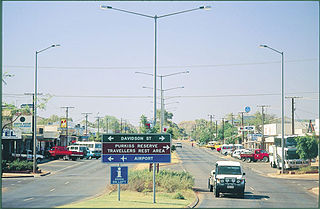
Darwin is the capital city of the Northern Territory, Australia. With a population of 139,902 at the 2021 census, the city contains most of the sparsely populated Northern Territory's residents. It is the smallest, wettest, and most northerly of the Australian capital cities and serves as the Top End's regional centre.

The Northern Territory is an Australian territory in the central and central northern regions of Australia. The Northern Territory shares its borders with Western Australia to the west, South Australia to the south, and Queensland to the east. To the north, the territory looks out to the Timor Sea, the Arafura Sea and the Gulf of Carpentaria, including Western New Guinea and other islands of the Indonesian archipelago.

Tennant Creek is a town located in the Northern Territory of Australia. It is the seventh largest town in the Northern Territory, and is located on the Stuart Highway, just south of the intersection with the western terminus of the Barkly Highway. At the 2021 census, Tennant Creek had a population of 3,080 people, of which 55% (1,707) identified themselves as Indigenous.

Stuart Highway is a major Australian highway. It runs from Darwin, in the Northern Territory, via Tennant Creek and Alice Springs, to Port Augusta in South Australia; it has a distance of 2,720 km (1,690 mi). Its northern and southern extremities are segments of Australia's Highway 1. The principal north–south route through the central interior of mainland Australia, the highway is often referred to simply as "The Track".

The Northern Territory Police Force is the police body that has legal jurisdiction over the Northern Territory of Australia. This police service has 1,607 police members made up of 83 senior sergeants, 228 sergeants, 912 constables, 220 auxiliaries, and 64 Aboriginal Community Police Officers. The rest of the positions are members of commissioned rank and inoperative positions. It also has a civilian staff working across the NT Police, Fire and Emergency Services.

Pine Creek is a small town in the Katherine region of the Northern Territory, Australia. As at the 2021 Census there were 319 residents of Pine Creek, which is the fourth largest town between Darwin and Alice Springs.

Australian Football in the Northern Territory is the most popular sport, particularly with indigenous Australian communities in Darwin, Alice Springs and the Tiwi Islands. It is governed by AFL Northern Territory.
Southport is an outer rural locality in Darwin. It is based on the site of the abandoned Town of Southport, a thriving river port during the Pine Creek gold rush of the 1870s. It is located at the junction of the Blackmore and Darwin Rivers.
Francis Xavier Gsell, OBE was a German-born Australian Roman Catholic bishop and missionary, known as the "Bishop with 150 wives". He was born at Benfeld, Alsace in 1872. He was ordained as a priest in the order of the Missionaries of the Sacred Heart in 1896, after study in Rome.
Rugby league in the Northern Territory is administered by the Northern Territory Rugby League and is played in Darwin at Warren Park and in Alice Springs at Anzac Oval.

Maurice William Holtze born in the Kingdom of Hanover, was a botanist who established Darwin's Botanical Gardens in Fannie Bay, Darwin in 1878. When he left to take charge of Adelaide's Botanic Garden in 1891, his son Nicholas was appointed curator of the Darwin Botanical Gardens in his place.

The Tennant Creek Telegraph Station is an historical site about 16 kilometres north of Tennant Creek in the Northern Territory of Australia.

Nobles Nob mine is a gold mine in the Northern Territory of Australia located in the locality of Warumunga about 13 kilometres (8.1 mi) south-east of the town of Tennant Creek. It was once the richest gold mine for its size in the world.

William Henry Charles Fullwood, better known as Bill Fullwood, was an Australian painter. He is considered one of the most significant artists from the Barkly region of the Northern Territory of Australia, best known for his depictions of scenes of the Barkly region. He was a long-term resident and mining pioneer of Tennant Creek. The historic Tuxworth Fullwood House is named after him.

Tuxworth Fullwood House is a historic building in Tennant Creek in the Northern Territory of Australia. It was known as the No. 55 Australian Camp Hospital during World War II becoming the Tennant Creek Hospital Outpatients Department after the war. It was the first brick building constructed in the town and is one of the last remaining military structures in the Barkly region.

Maranboy was a tin mine near Barunga, about 70 kilometres east of Katherine in the Northern Territory of Australia.

James (Jim) Joseph Mannion was a renowned policeman and soldier who worked in the Northern Territory of Australia. He is best known for an act of bravery clearing a burning building of occupants, an act which saw him awarded a George Medal.

The Territory Labor Party, officially known as the Australian Labor Party (Northern Territory Branch) and commonly referred to simply as Territory Labor, is the Northern Territory branch of the Australian Labor Party. It is the current ruling party in the Northern Territory and is led by Natasha Fyles, who has concurrently served as chief minister of the Northern Territory since 2022, and previously Michael Gunner from 2016 to 2022.
Ali Curung is an Indigenous Australian community in the Barkly Region of the Northern Territory. The community is located 170 km (106 mi) south of Tennant Creek, and 378 km (235 mi) north of Alice Springs. At the 2021 census, the community had a population of 394.

Powell Creek Telegraph Station was a repeater station for the Australian Overland Telegraph Line and it sat between the Tennant Creek Telegraph Station and the Daly Waters Telegraph Station. It was one of the more important telegraph stations along the line as inland weather conditions were so favourable that not all stations where required to support the line.


















